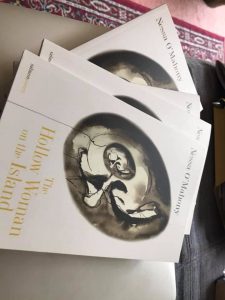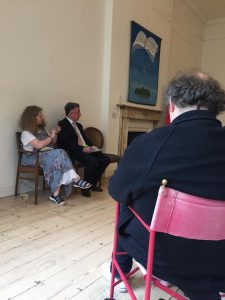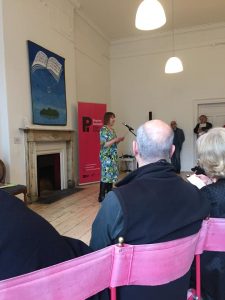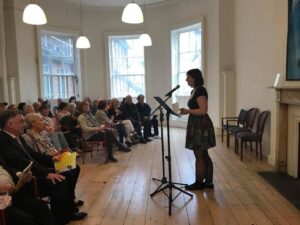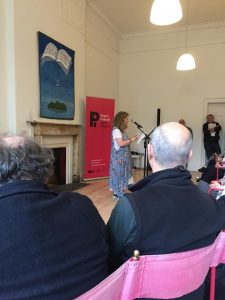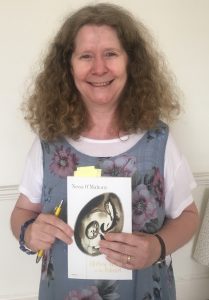We had great fun launching my fifth poetry collection, The Hollow Woman on the Island, at Poetry Ireland on 28th May. I was in excellent company, as Jo Slade and John Murphy were also launching new volumes with Salmon Poetry, our publisher. I was also incredibly lucky to have the amazing Katie Donovan as my ‘launcher’ – here’s her very generous comment on my new book, which can be ordered online from Salmon’s website at https://www.salmonpoetry.com/details.php?ID=509&a=281
“Themes of family, mortality, faith and art inform this new collection from Nessa O’Mahony. Although the title, The Hollow Woman on the Island, suggests loss and limbo, the book rings with birdsong, the fluting of an old gate in the wind, family anecdotes from Cork to Vienna, and concludes: “prayer starts in the same place as story”.
Many years ago, Nessa’s bright enthusiastic face and incisive comments lit up my Creative Writing class in the IWC. Her consistent output ever since – from four volumes of poetry to her novel, The Branchman, and her work as an editor of two anthologies – has brought her to the centre of the writing scene in Ireland and abroad. This is her fifth collection of poetry – another book to be proud of. And may I say, as her former “teacher”, how proud I am as well.
There are several powerful poems in The Hollow Woman on the Island that give voice to a fear so many of us have known, as doctors hover with scalpels and jargon, offering “butcher’s cuts of possibility”.
The unbearable, post-surgery lightness which, for a woman who has lost her fertility, is so cruelly ironic in its ovoid shape, is expressed beautifully and heart-wrenchingly in the title poem. A similar delicate approach is evident in “Alcmene’s Dream”, which ends with an absent cradle, and first appeared in Metamorphic, the anthology of poetic responses to Ovid which Nessa co-edited in 2017.
With the beautiful poem in celebration of her niece’s wedding, Nessa brings this theme to bear on the larger picture of a family and its collective fertility – the significance of the role of each member within that circle.
Nessa’s well-known gravitational pull towards history is evident in many of the poems, one of the most eloquent being “O’Leary’s Grave” where some of Ireland’s shamefully large population of homeless citizens bed down in Croppies Acre while a scene is shot for a movie about The 1916 Rising.
Her capacity to depict landscape with the deft shapes and colours of a painter’s eye is also in evidence, from the Bohea Stone in Mayo to Cill Rialaig in Co Kerry, and our own local river, the Dodder. Wildlife abounds, from fledgling wrens to otters and hares.
Wisdom, lightness of touch, vulnerability, craft and ironic flourishes. Family, travel, friendship and political awareness. There is much to mine in this new work.
Finally, I like how she chooses to end the collection, with a vision of Homer as a woman. For we know that Homer represents a collective circle of narrators, within a large family of storytellers, each with a vital contribution to make to the endeavour as a whole.”
Katie Donovan, at Poetry Ireland, 28th May 2019.
